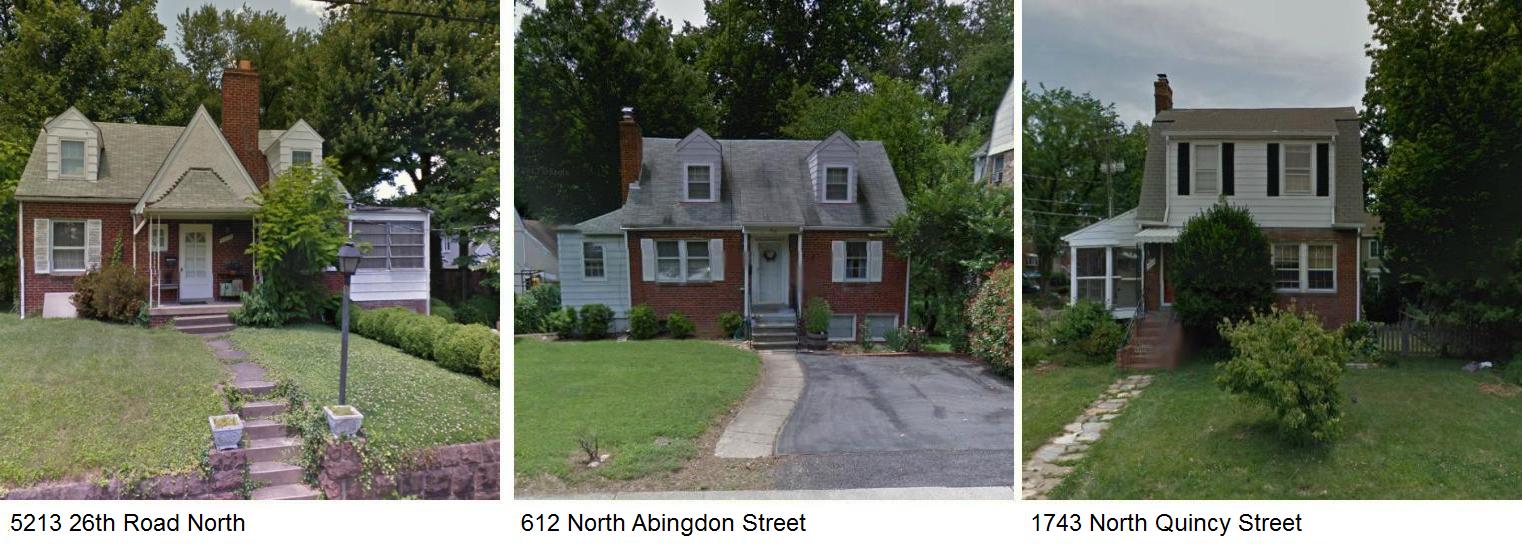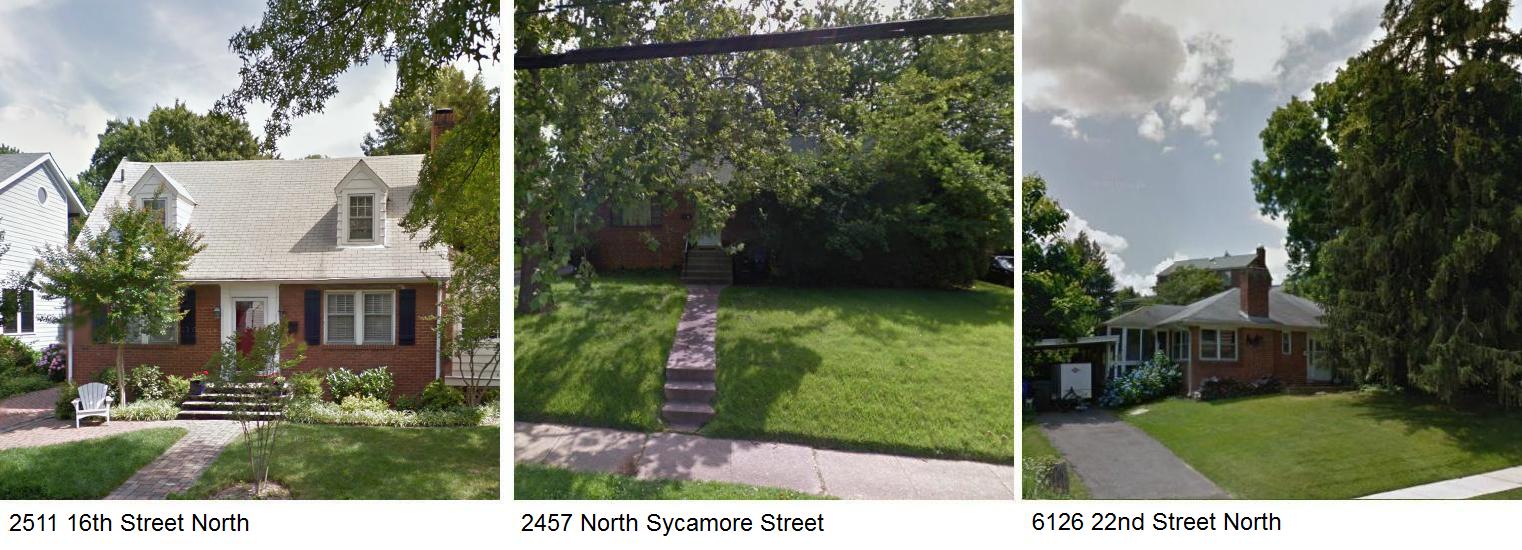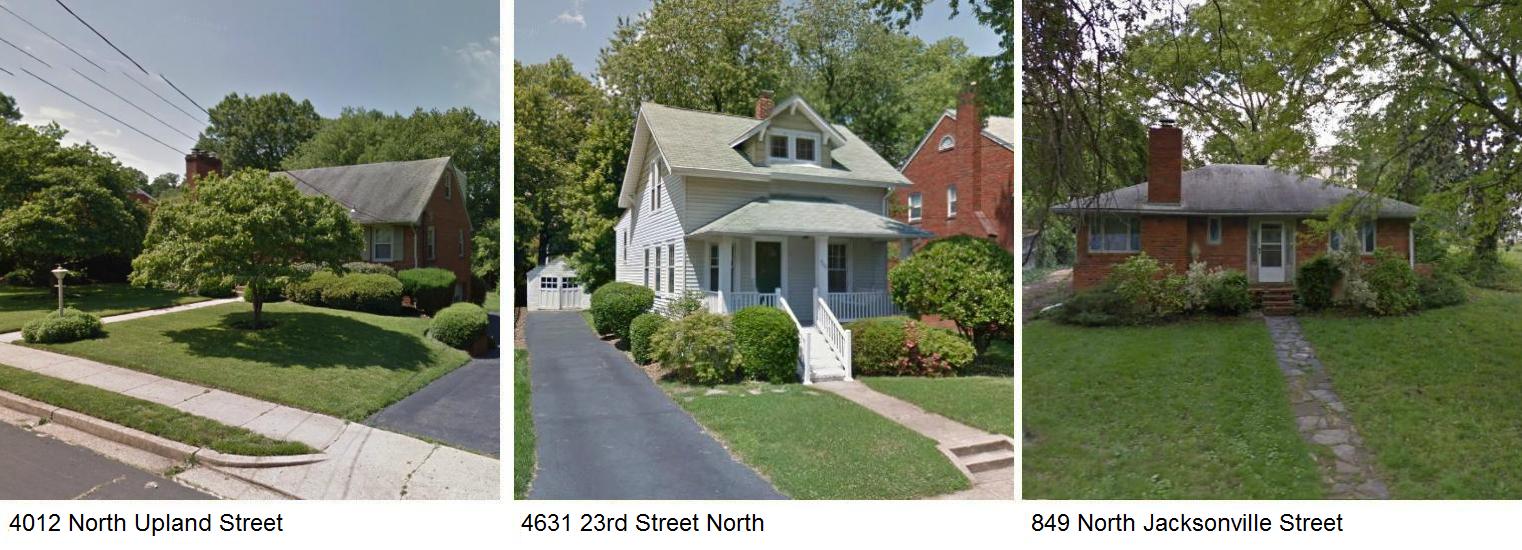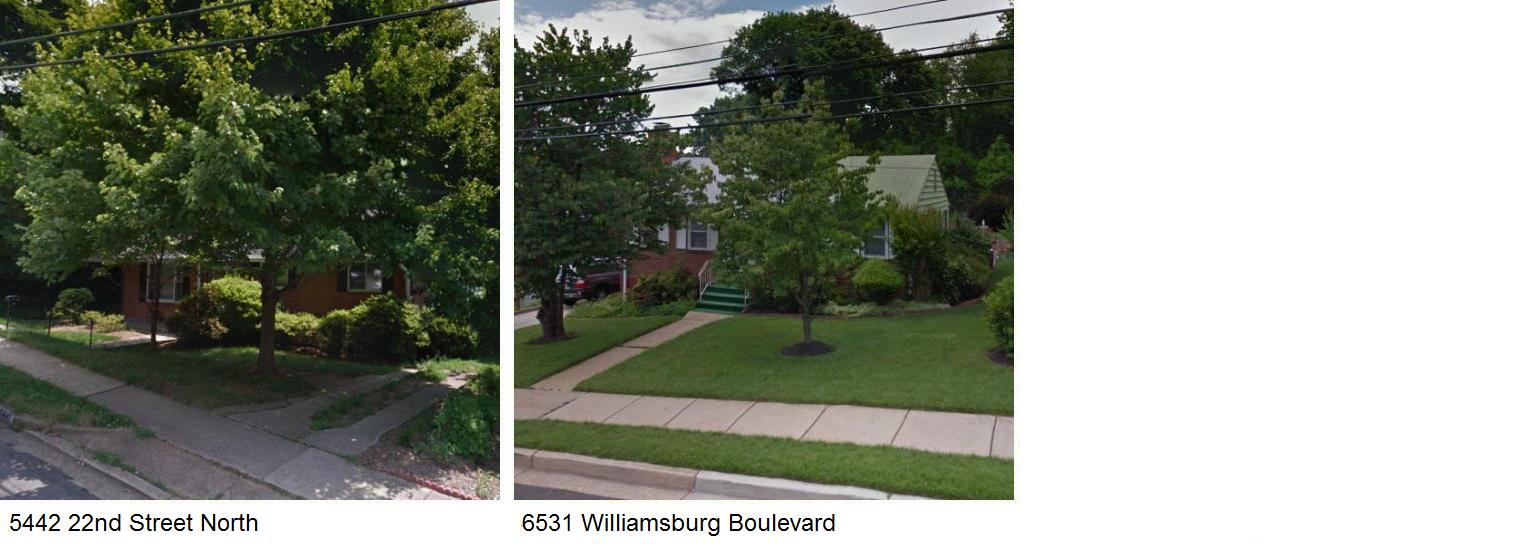LOST: February 2014 Snapshots
In February 2014 a total of 11 demolition permits were applied for in Arlington County, all of which were for single family homes (see photos below).
All of the homes are located in North Arlington and the majority (seven) are north of Lee Highway. Three are located in National Register Historic Districts: 1743 North Quincy (Cherrydale Historic District), 2511 16th Street North (Lyon Village Historic District), and 6126 22nd Street North (Highland Park/Overlee Knolls Historic District). Several of the homes are located in neighborhoods that could qualify for historic designation under National Register criteria.
In a review of the Arlington County tax records, it appears that seven of the 11 houses are owned by builders and are speculative redevelopments, and three are being redeveloped by individuals who bought the property within the last year.
Cumulative demolition total for 2014:
- – four are located in National Register Historic Districts
– 15 are speculative developments
Commercial buildings: 1
The looming demolition of these houses and buildings represents an incredible loss of history, architecture, time, energy, and materials. Many had the potential for renovation and additions, or, at a bare minimum, reclamation/reuse of building materials. These buildings are often replaced with new construction that is out of scale and proportion to the community. Preservation Arlington urges citizens to adopt Local Historic District designations for their communities, with standards for design, height, and placement that could be customized to reflect community needs while still allowing reinvestment to occur.
Similarly, if you are a property owner and are contemplating a change to your property, Preservation Arlington encourages you to work with your architect or builder to consider how some or all of your house or building could be incorporated into a renovation, or the materials reused.




7 thoughts on “LOST: February 2014 Snapshots”
Why is all (or practically all) of your list in North Arlington? Is there nothing of concern to be saved in South Arlington??
Alan:
Thanks for noting that these properties this month are completely in North Arlington. That is correct. We mentioned this because this is the first time that ALL demolitions were in North Arlington.
But, that is not our choice. We are just reporting on properties for which demolition permits have been requested. We are just compiling data from Arlington County.
One of those houses could be described as charming, the rest appear to be small, fairly ugly homes. Not sure why anyone will regret their passing. These are not the painted ladies of S.F., or even the functional equivalent of Roman tract housing that at least has some aesthetic appeal and is built to last.
You say many of the houses have reclamation/reuse potential, as if the owners presumptively aren’t planning that. Our house, featured in one of your recent “LOST” columns, was completely deconstructed and donated — at $xx,xxx additional cost to us to ensure the salvageable content avoided the landfill. The contractor who did the project had three others going at the same time. So it isn’t fair to say that every demo permit in Arlington equates to a house wasted.
Our new home will also have only a marginally greater footprint than the old one, but will be more energy efficent, and will result in less runoff to the watershed. We will also pay more taxes to the county, when our assessment rises. In short, not all change is bad.
Thank you for your note.
You bring up an excellent point about our posts and the demolition of these homes. While we have been mostly focused on the fact that they are being demolished we have not been able to research how many are being deconstructed. It is great to hear that this happened on your home. Unfortunately you are probably the exception as most houses seemed to be pretty much bulldozed. We can adjust our reporting to reflect your comments.
It would be actually very educational to write-up about what you did. If you could email us at preservationarlington at gmail.com we can talk more.
Thank you.
I’d rather not identify myself or my home with respect to the specifics of our project — too many people seem to be reflexively against the decision to go with new construction — but I can tell you this:
Our builder told us early during the process of designing our home that deconstruction was an option. We researched it, and found at least three companies serving Arlington for deconstruction — Deconstruction Services, Go Green, and Second Chance. I’m sure there are others. We picked one. We signed a contract with them, which involved our paying them to bring a crew to our home and pull all the reusable materials out of the house — all the structural wood, the hard wood flooring, cabinets, wiring, plumbing, plumbing fixtures, light fixtures, appliances, windows, furnace, water heater, garage door, garage door opener, etc. Over a period of a couple weeks after issuance of our demo permit, they extracted those materials and bundled them together. They were then donated to Community Forklift, a surplus building material company in suburban Maryland.
What ended up in the landfill after the decon crew finished was primarily roof shingles, insulation, plasterboard from the interior walls, wood that was too rotted to re-use (rot issues contributed in part to our decision to tear down rather than renovate), exterior brick (we’d hoped to salvage that, but they were hollow bricks filled with mortar, that aren’t readily salvageable), and the cinder block and concrete foundation.
In terms of why we chose to tear our house down and build from scratch, rather than renovate or expand, the decision was complex and long-considered. The biggest considerations were these three:
1. Our existing house, a largely un-upgraded (and, frankly, generic) structure from the 1950s, was reaching the end of its useful life. It required major investments simply to preserve the status quo. Aside from needing a new roof, more efficient HVAC, and the electrical system brought up to code, it was built with a cinderblock foundation. Over a 60 year period, that foundation had started to leake and had settled badly (resulting in crooked floors, and many cracked walls — interior and exterior). To simply return the home to ‘normal’ would have been an expensive project that would have been disruptive to our lot. In short, the economics didn’t warrant putting more money into the existing structure.
2. Given the split-level layout of our existing house (and the structural issues noted above), we couldn’t pop the top and add a floor. We also couldn’t build out into the yard without consuming the best parts of our usable outdoor space. If we built from scratch, however, we could take the existing footprint and use the space better, by tweaking things at the margins. By adding a couple feet on either side and eight to ten feet along parts of the back, and also going downward (by adding a deeper full basement), we will have a house that is only a bit taller than the old house at the highest point, but has almost 60% more usable interior space. It also lets us flatten out a portion of our yard we never used, to give us MORE out door space that is usable day-to-day than we had prior to the build.
3. We love our neighborhood and we love our neighbors, but we needed more space for an expanding family. We knew — because we’d received multiple unsolicited letters — that if we sold the house to move elsewhere, a developer would come in and tear it down anyway. With renovation not a viable way to get more space, we wanted to control that process so we could build the smallest ‘bigger’ house that met our needs. By code, we could have gone almost twice the size of our footprint if we’d wanted to maximize the size of the house. Instead, we put the yard first and did what we could to minimize deviations from our old footprint. Our builder told us we weren’t alone in prioritizing that, as most folks who plan to live in the houses they design want to keep the yard as much as they can.
So, my take away is only this — not every house in Arlington is worth saving, and not every demolition project is created equal. I concede that many of the builders who buy houses and build them on spec without a buyer lined up are doing so without any regard for their neighbors or how they’ll use the lot (the ill-fated “Gigantor” on Westmoreland in Falls Church comes to mind).
But I believe that many of the folks you’ve lumped in with them — specifically those like us who buy old houses, live in them awhile, and then tear them down to build their ‘forever’ homes –deserve some more credit than they seem to have gotten. Anecdotally, my sense is about half of the new build projects near us fall into that category. These are houses that never hit the market after construction concludes, except for the builder to transfer title to the home owner. I’d see if you can get to the bottom of that stat — how many of the new build projects result in a new home sale some months after construction is done, without an MLS listing — as that may be more indicative of speculative and unchecked growth vs. folks making personal choices about utilizing their own land.
I do agree with your overall point that we should try to preserve what we can. But preservation for perservation’s sake, without weighing the benefits of starting over with a given home, is not productive either. Somewhere in between is a good, sustainable path towards bringing our community into the future.
–A North Arlingtonian
Thank you for the insightful response.
Based on feedback we are now identifying which houses are in one of our National Register Districts.
We are also indicating how many of the houses are being done as speculative demolitions (the majority). The idea of counting the transactional demos is to show that much of this is being done as profit centers, and not by owners such as yourself. There are different goals and thus different methods being followed.
We are already working on a blog post to discuss how demolition can be done in a more environmentally sensitive manner. That materials can be re-used, recycled and reclaimed.
Preservation Arlington is on record that we are not opposed to development and redevelopment. We are trying to get a dialogue going about what can be done to best manage our resources as our County continues to grow.